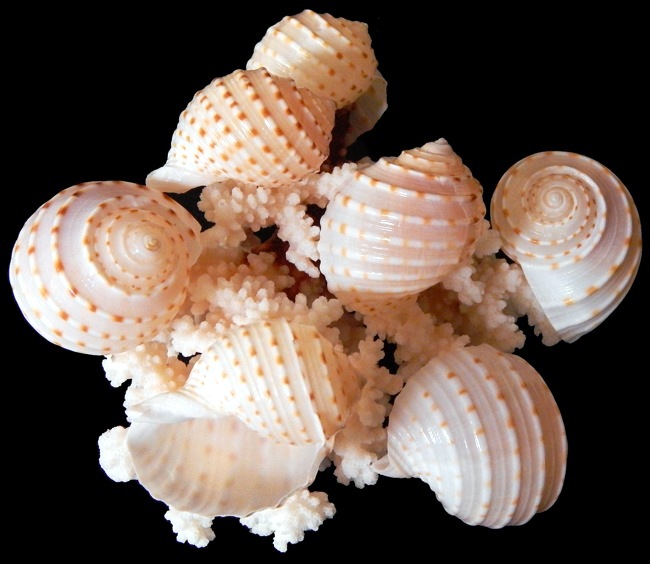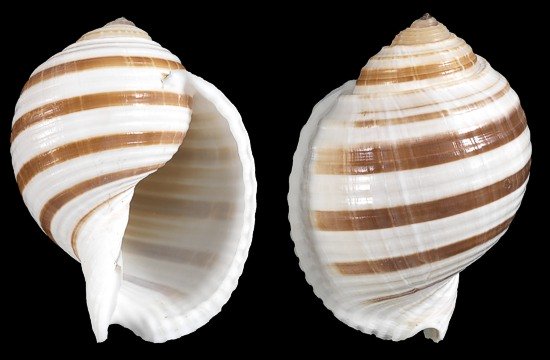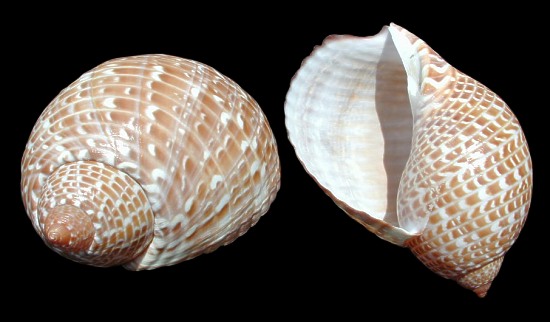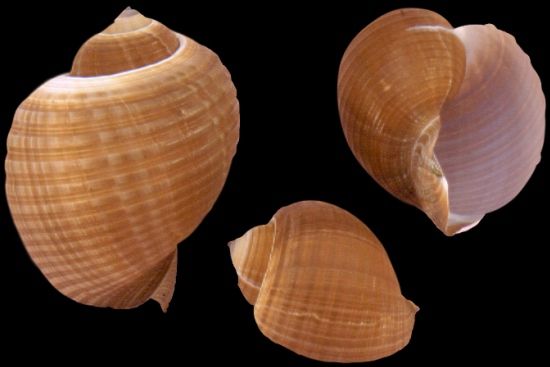TONNA SHELL KNOWLEDGE BASE II

The Indian Tonna Tessalata, also known as the Spotted Tun, is a smaller variant of the Tonna Tessalata shell, commonly referred to as the Indian Tonna. These are small, delicate, and spiraled with a low spire. The outer lip concludes in a shallow siphonal notch. The body whorl features 10 to 20 spiral ribs, adorned with white, cream, or pale brown colors and square-like blotches on the ribs, while the apex is brown. This species is distributed from the western Indian Ocean eastward to the northern shores of Australia and New Zealand, and northward to the southern coast of Japan. The average size of the shells found is about 5 inches, and they are deemed moderately common. Its scientific name is Tonna Dolium.

Tonna sulcosa, also known as the banded tun, is a species of large sea snail. It is a marine gastropod mollusk belonging to the Tonnidae family, commonly referred to as tun shells.
The shells of Tonna sulcosa typically range from 2 to 6 inches in length. These medium-sized, robust shells are oval-globose with 4 to 5 moderately convex whorls and distinct flat ridges. They feature a large, semi-circular aperture with a reflected lip and elongated, sharp teeth. The shell's surface is white, adorned with 3 to 5 broad brown bands.
The shell of Tonna Selacosa is ovate and ventricose, predominantly whitish with four or five bands of reddish fawn color, which seldom extend to the outer lip. The two whorls above the base feature a single band. Its spire, brown at the apex, comprises six convex whorls adorned with narrow, flat ribs that are more spaced out towards the top, separated by shallow grooves. The upper whorls display a checkered pattern due to intersecting striae. The suture is slightly flattened and channeled. The ovate aperture is white with a red hue at the base. The arcuated outer lip has a protruding margin, crenulated on the outside by the ribs, undulated on the surface, and dentated on the inside. The columella is twisted, and some specimens show crenulations near the base of the inner lip, which partially covers the umbilicus. The periostracum is thin and has a reddish tint.
The Tonna Selacosa species is prevalent throughout the tropical Indo-West Pacific region, ranging from the Red Sea and the Indian Ocean to Indo-China, the Philippines, and Australia, including Queensland and Western Australia. These benthic gastropods live on sandy bottoms in tropical environment at depths of 33 to 229 feet.
Scientific classification
Domain: Eukaryota
Kingdom: Animalia
Phylum: Mollusca
Class: Gastropoda
Subclass: Caenogastropoda
Order: Littorinimorpha
Family: Tonnidae
Genus: Tonna
Species: Tonna sulcosa
Binomial name: Tonna sulcosa(Born, 1778)
(REF: Born I. von (1778). Index rerum naturalium Museum Caesarei Vindonbonensis pars 1, testacea. Kraus, Vienna pp. XLII + 458:. World Register of Marine Species)(REF: Tonna sulcosa (Born, 1778). Vos, C. (2009). Tonna sulcosa (Born, 1778). Accessed through the World Register of Marine Species)(REF. "Tonna (Sulcosa complex) sulcosa". Gastropods.com.)(REF:Ramsay, E. P. Distribution at Biodiversity Library - Records of the Australian Museum)

onna Perdix, commonly known as the partridge tun, is a species of very large sea snail, a marine gastropod mollusc in the family Tonnidae, the tun shells.
The pattern and brownish color of the shell is reminiscent of a partridge's plumage hence the common name. The size of an adult shell varies between 2 3/4 to 8.5 inches.
The shell, ovate-oblong and ventricose, is rather delicate. It boasts a reddish-brown hue, attractively interspersed with white spots arranged in transverse, mostly semi-lunar series that vary in proximity. The conical spire protrudes slightly and comes to a point. It consists of five to six whorls, adorned with numerous ribs that are often broadened, subtly convex, and set apart by scarcely visible furrows. The suture is pronounced and subtly grooved as it approaches the body whorl. The aperture is ample and subovate, characterized by transverse, slightly protruding bands aligning with the furrows on the shell's exterior. The cavity's interior presents a fawn shade. The outer lip is slender, turned outward, slightly wavy, and features a white band running its full interior length, save for the edge, which is a deep brown. The inner lip extends across the shell's body, ultra-thin, translucent, and culminates in a protruding plate that conceals the umbilicus, appearing to be part of it. The columella is sleek, lustrous, and on the umbilicus's left, it forms a robust rib, distinguished by transverse striations, concluding at the base's notch.
The ground color of the shell is a bluish white, covered with irregular spots of a red brown, bordering upon the violet. The foot is colored in the same manner beneath, but above, it is furrowed with wide triangular radiating bands. The tentacles are doubly ringed with brown.
This species is found in the Red Sea, the Indian Ocean near Aldabra, Chagos, Madagascar, the Mascarene Basin, Mauritius, Tanzania, and in the Pacific Ocean near New Zealand, Australia (Northern Territory, Queensland, Western Australia), and the Galapagos Islands. The mollusk inhabiting this shell is known to dwell in swift currents and is quite agile in its movements.
This Tun shell is a highly specialized carnivorous predator, preying on sea cucumbers.
Scientific classification
Domain: Eukaryota
Kingdom: Animalia
Phylum: Mollusca
Class: Gastropoda
Subclass: Caenogastropoda
Order: Littorinimorpha
Family: Tonnidae
Genus: Tonna
Species: Tonna perdix
Binomial name: Tonna perdix(Linnaeus, 1758)
(REF: Vos, C. (2010). Tonna perdix (Linnaeus, 1758). Accessed through: World Register of Marine Species)(REF: Kiener (1840). General species and iconography of recent shells : comprising the Massena Museum, the collection of Lamarck, the collection of the Museum of Natural History, and the recent discoveries of travellers; Boston :W.D. Ticknor,1837 (described as Dolium perdix)(REF: Philippe Bourjon; Sébastien Vasquez (2016). "Predation by the gastropod Tonna perdix (Gastropoda: Tonnoidea) on the holothurian Actinopyga echinites (Echinodermata: Holothuroidea) on a reef of Réunion" (PDF). SPC Beche-de-mer Information Bulletin. 36.)
